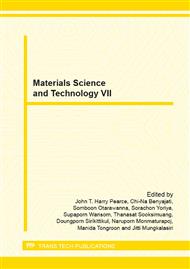p.101
p.109
p.115
p.122
p.129
p.134
p.143
p.148
p.153
Comparison on Pore Development of Activated Carbon Produced from Scrap Tire by Potassium Hydroxide and Sodium Hydroxide for Active Packaging Materials
Abstract:
Activated carbons were prepared by chemical activation from scrap tire with two chemical reagents, NaOH and KOH. The activation consisted of different impregnation of a reagent followed by carbonization in nitrogen at 700°C. The resultant activated carbons were characterized in terms of BET surface area, methylene blue adsorption and iodine number. The influence of each parameter of the synthesis on the properties of the activated carbons was discussed, and the action of each hydroxide was methodically compared. It is the first time that preparation parameters and pore texture characteristics are simultaneously considered for two closely related activating agents of the same char precursor. Whatever the preparation conditions, it was shown that KOH led to the most microporous materials, having surface areas and adsorption properties (methylene blue adsorption and iodine number) higher than those obtained with NaOH, which was in agreement with some early works. However, the surface areas, methylene blue adsorption and iodine number obtained in the present study were much higher than in previous studies, up to 951 m2/g, 510 mg/g and 752 mg/g, respectively, using scrap tire waste char:KOH equal to 1:1. The thorough study of the way each preparation parameter influenced the properties of the final materials bought insight into the activation mechanisms. Each time it was possible; the results of scrap tire waste chemically activated with hydroxides were compared with those obtained with anthracites; explanations of similarities and differences were systematically looked for.
Info:
Periodical:
Pages:
129-133
Citation:
Online since:
March 2013
Keywords:
Price:
Сopyright:
© 2013 Trans Tech Publications Ltd. All Rights Reserved
Share:
Citation:


